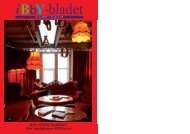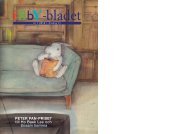Anna-Clara Tidholm
Anna-Clara Tidholm
Anna-Clara Tidholm
Create successful ePaper yourself
Turn your PDF publications into a flip-book with our unique Google optimized e-Paper software.
about the last and lonely time of<br />
an old guinea pig. His family has<br />
been scattered and only his own<br />
thoughts about their past remain.<br />
This is a tender story about a good<br />
aging process of integration while<br />
death is unavoidably getting closer.<br />
<strong>Anna</strong>-<strong>Clara</strong> <strong>Tidholm</strong> pictures, in a<br />
rather naturalistic way, a carefully<br />
personified guinea pig (not dressed)<br />
living in a relationship with a caring<br />
owner/person in a tiny house<br />
with small furniture, a mailbox and<br />
a working mail system. The death<br />
process is told on the seven last<br />
spreads from the moment he is too<br />
weak to rise from his bed until the<br />
funeral is over and the reactions to<br />
his death begin to show (e.g. in the<br />
TV-news) in mildly ironical final<br />
scenes.<br />
While “Good bye, Mr. Muffin”<br />
won immediate acclaim also among<br />
adult readers the most recent book<br />
by the <strong>Tidholm</strong>s, “Snälla barn”<br />
8<br />
(“Nice Children”, 2007), encountered<br />
more skepticism among adult<br />
intermediaries. The story is about<br />
two half sisters who spend their<br />
afternoons alone at home after<br />
school. On this particular day both<br />
parents are late and the girls have<br />
to manage on their own until their<br />
father/stepfather returns.<br />
Basically the story is without<br />
drama, it is a realistic description<br />
of life in a modern step family. The<br />
children act as a liason between<br />
the two absent parents, who try<br />
to direct their lives via cell phones<br />
rather than to cooperate. <strong>Anna</strong>-<br />
<strong>Clara</strong> <strong>Tidholm</strong> attempted initially<br />
to illustrate the book with her usual<br />
water color technique but almost at<br />
once turned to her children’s crayon<br />
technique. As in “Åke-boken”, in<br />
the deeply philosophical “Lanas<br />
land” (1996) and in “Hanna, huset,<br />
hunden”, there is in “Snälla barn”<br />
something unstated that sets the<br />
reader’s imagination in motion.<br />
One suspects that this family life<br />
is not easy and one does not really<br />
know why the mother is late. There<br />
is a suggestion that this family perhaps<br />
will not stay together.<br />
“Crayons and colour pencils allow<br />
for a higher degree of naïvité<br />
than water colour”, says <strong>Anna</strong>-<strong>Clara</strong><br />
<strong>Tidholm</strong>. “They reduce the psychological<br />
temperature making it less




